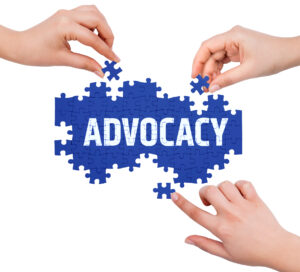 Question from the field: “I have several students with hearing loss who are high functioning, fully mainstreamed, and get good grades. My administrators feel like the students can be dismissed from the IEP process, but I know there are still areas of need for me to work on. How can I support these students?”
Question from the field: “I have several students with hearing loss who are high functioning, fully mainstreamed, and get good grades. My administrators feel like the students can be dismissed from the IEP process, but I know there are still areas of need for me to work on. How can I support these students?”
As we know, in Special Education, grades do not reflect equal educational access1. It is fairer to say that grades reflect a student’s background knowledge, and degree of student effort to try to figure out the information they regularly miss due to lapses in auditory access and incidental learning. Students with hearing loss are typically working much harder than their hearing peers in class due to many factors such as fragmented speech perception, ambient noise and distance from the speaker, which can affect access to what is being said by teachers, peers, and other speakers. No matter how successful the student with hearing loss is as measured by grades, the sheer volume of the amount of information coming at them all day causes auditory fatigue, anxiety, and at times even social isolation2.
In addition to communication access factors that can get in the way, students  with hearing loss who have good grades often continue to have discrepancies in vocabulary, both foundational and academic, immature social communication skills, degraded auditory skills in the presence of noise, difficulties with pragmatic language, a lack of understanding of their own hearing loss and their accommodations, and a need for additional self-advocacy skills to be addressed and supported.
with hearing loss who have good grades often continue to have discrepancies in vocabulary, both foundational and academic, immature social communication skills, degraded auditory skills in the presence of noise, difficulties with pragmatic language, a lack of understanding of their own hearing loss and their accommodations, and a need for additional self-advocacy skills to be addressed and supported.
Below is a small sampling of students with whom I have worked who are very high functioning, and still have deficits that support the need for an IEP:
5th grade student: This boy uses both a hearing aid and a cochlear implant. He has been in the mainstream since early elementary school. His IEP team did see the need for goals and services, but the “aha moment” came during a Listening and Spoken Language session when it was discovered that, due to lack of incidental hearing, he had never learned all of the vocabulary that goes along with bedding and linens. With this clear example of how much incidental learning he was missing his team added CART to his IEP.
High school sophomore: This student has always been placed in the mainstream setting and is extremely bright. While she had been a candidate for a CI for many years, it wasn’t until her sophismore year that she decided to get the implant. With her hearing aids she could not hear the questions or comments from her peers or whole-class discussion. She told me that during unstructured times in class and on campus when her friends would talk to her she would just nod her head and hope it was the right answer. She was in honors classes, on a sports team, and earning good grades, but she was not accessing linguistic information in school.
High School senior: This girl wears bilateral hearing aids and has always been placed in the mainstream setting. She has always gotten good grades as well as being an accomplished athlete. Her testing showed that she did not have any academic needs, but the DHH providers were able to share data with the administration showing that she still had deficits in communication, auditory skills, and self-advocacy that needed to be addressed in IEP goals prior to graduation.
There are endless examples of high functioning students with hearing loss from every educational level who, despite their “good” academic grades and their ability to have conversations one-on-one in quiet, continue to struggle in the educational setting. Grades do not equal access to education.
To be considered eligible for specialized instruction in public school, the student (1) must have a qualifying condition (i.e., hearing loss), and (2) must need specialized instruction in order to get the benefit of his/her education. Another term for this is that the student must exhibit an adverse educational effect from the disability area, which is subject to local definition and interpretation. Nowhere in IDEA is it written that only students with academic deficits (aka ‘bad grades’) can be eligible for special education services. Access to education and proposed goals are not limited to reading, writing, and math. Often the tests used in an evaluation do not have sufficient scope or depth to identify the more subtle or underlying gaps in skills. Assessment in the areas of listening, auditory skill development, attention, pragmatic language, communication, and social and behavioral skills should be included in addition to an in-depth language assessment3.
 For children who are deaf or hard of hearing, the definition of adverse effect should also be determined by a student’s progress as well as their performance at the time of evaluation. If a child has not met the expectation for one year of growth in one year’s time, he should receive special education and related services. Ultimately, the school district is accountable for students it finds ineligible for special education. If those students do not make adequate annual progress – one year’s growth in one year’s time – the parents can take legal action to prove the school’s liability4.
For children who are deaf or hard of hearing, the definition of adverse effect should also be determined by a student’s progress as well as their performance at the time of evaluation. If a child has not met the expectation for one year of growth in one year’s time, he should receive special education and related services. Ultimately, the school district is accountable for students it finds ineligible for special education. If those students do not make adequate annual progress – one year’s growth in one year’s time – the parents can take legal action to prove the school’s liability4.
Teachers of the deaf/hard of hearing can obtain data in the following areas of need in preparation for an IEP in order to identify baselines and new goals:
- 1. Listening to a degraded signal (noise, distance, audio recordings, videos)
- 1. Following class discussion
- 2. Following and participating in a conversation with a partner or small group with other small groups also conversing
- 3. Understanding verbal directions without visual support in the presence of noise (i.e., playground, PE, assemblies)
- 4. Auditory comprehension when listening to a recording or computer voice
- 2. Social Communication
- 1. Independently initiating conversations with peers during unstructured times
- 2. Joining an existing conversation and maintaining topic not of their choosing
- 3. Explaining their hearing loss and/or accommodations to familiar/unfamiliar adults and/or peers
- 4. Communication repair when they are not understood
- 5. Asking for clarification when they do not understand their communication partner
- 3. Self-Advocacy
- 1. Care and maintenance of hearing assistance technology (i.e., hearing devices)
- 2. Consistent use of hearing assistance technology
- 3. Using appropriate language to report when hearing technology is not working, needs to be turned on, or needs to be muted
- 4. Understanding and asking for accommodations as appropriate for grade level (this can grow over time)
- 5. Independently asking for clarification of directions/assignments/discussions in an age appropriate manner
Students with all levels of hearing loss can suffer from what is referred to as  Swiss cheese hearing. They do hear, so they don’t always know what they did not hear. When the general education teacher or the student self-reports that they “heard everything” the teacher of the deaf/hard of hearing can support the team in ways to determine what may have been missed. They can advocate for self-advocacy goals, and other IEP goals as appropriate. A very helpful resource for on-going training of general education teachers and non-DHH providers and IEP team members is “I know he can hear me.” The surprising impact of hearing loss on comprehension5 and The Cascading Impact of Hearing Loss6.
Swiss cheese hearing. They do hear, so they don’t always know what they did not hear. When the general education teacher or the student self-reports that they “heard everything” the teacher of the deaf/hard of hearing can support the team in ways to determine what may have been missed. They can advocate for self-advocacy goals, and other IEP goals as appropriate. A very helpful resource for on-going training of general education teachers and non-DHH providers and IEP team members is “I know he can hear me.” The surprising impact of hearing loss on comprehension5 and The Cascading Impact of Hearing Loss6.
References
- Howey, Patrica (2016). Good Grades: Does My Child Still Need Special Instruction? https://www.wrightslaw.com/nltr/16/nl.0607.htm
- Tiredness in Deaf Children http://www.ndcs.org.uk/family_support/education_for_deaf_children/education_during_school_years/tiredness.html
- Johnson, C., DesGeroges, J., Seaver, L. (2013). Educational Advocacy for Students who are Deaf or Hard of Hearing: The Hands & Voices Guidebook. Chapter 3: A Question of Eligibility.
- Forest Grove School District v. T.A. www.wrightslaw.com/law/caselaw/ussupct.forest.grove.ta.pdf
- Anderson, K. L. (2014). Supporting Success for Children with Hearing Loss https://successforkidswithhearingloss.com/wp-content/uploads/2019/01/I-know-he-can-hear-me-handout-for-teachers.pdf
- Anderson, K. L. (2017). The Cascading Impact of Hearing Loss: https://successforkidswithhearingloss.com/wp-content/uploads/2014/06/The-Cascading-Impact-of-Hearing-Loss2.pdf
Author: Melinda Gillinger, M. A.
Special Education Consultant
www.melindagillinger.com
